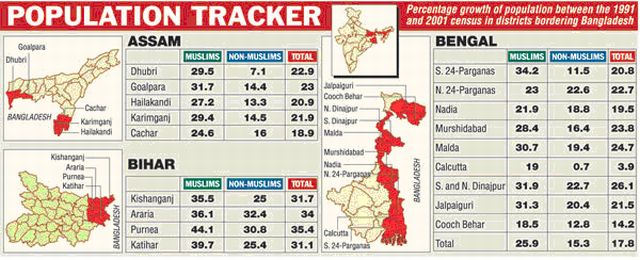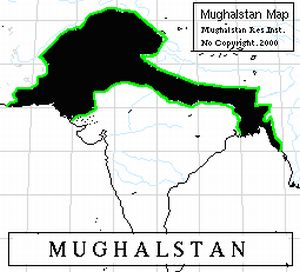Ominous signs for India 's state of West Bengal as it is posited to be the first sacrifice on the altar of Mughalistan, a new design to create a contiguous Muslim homeland in South Asia , which is well underway...West Bengal Bangladesh ) and West Bengal in 1947, only one district of West Bengal, namely Murshidabad, was dominated by Muslims. But at present, two other districts, Maldah and North Dinajpur , have been added to the list.West Bengal area, also has a majority of Muslim population.Bangladesh Cooch Behar Bangladesh West Bengal . In state of Assam India West Bengal fast turning into Muslim Majority area

“All this has been revealed by a recent report of the union home ministry on infiltration from India Assam West Bengal .
“Again, an analysis upon the projection into the 2001 Census hints at abnormal Muslim growth everywhere in West Bengal , where the Muslim population is 28% of the total state population”, says an analyst.
Similarly, the fate of 40 Assembly seats in Assam
“There have been reports that more Madarsas and mosques are sprouting along the borders, which in itself is an indication of increased Muslim population in the area," disclosed an intelligence official.
The Intelligence Bureau and the Home Ministry conducted their last study in 1992, and the report was kept secret, because of sensitive nature of the findings. It was ultimately leaked and the estimated number of illegal migrants from Bangladesh
It is time for a fresh study to determine the exact figure for illegal Bangladeshi Muslim infiltrators in West Bengal . There have been new intelligence reports that militants are using madarsas and mosques as safe-havens, and for storing arms and ammunition. According to reports, a large number of madarsas and mosques have mushroomed in bordering areas with Nepal , lower Assam and Bengal . This agrees another secret survey that has revealed that nearly 40% villages in the border districts of Bengal are predominantly Muslim. There are reports that concentration of the Muslim community, including the Bangladeshi immigrants in the villages, has resulted in the majority Hindus moving to urban areas.
Along with madarsas and mosques, a large number of Muslim NGOs have sprung up in the area bordering Nepal India Saudi Arabia , Kuwait , Libya
Figure 2: The districts of West Bengal, Assam and Bihar, bordering Bangladesh

As a result of these developments, the Bangladeshi Muslims are now virtually controlling the affairs of the West Bengal state Assembly, and dictating terms to the state government of West Bengal in all respects as Muslim electorates have a clear majority in as many as 53 out of 294 Assembly constituencies in the state. Consequently, the plight of majority Hindu electorates worsened in the State.
There are at least 5 powerful Muslim ministers in the West Bengal state cabinet, namely Abdur Rezzak Mollah (Minister of Land & Land Reforms), Anisur Rahaman (Minister of Animal Resources Development), Mortaja Hossain (Minister of Agriculture, Marketing & Relief), Anarul Haque (Minister of State for Public Health, Engineering) and Abdus Sattar (Minister of State for Minority Development & Madrasa Education), looking after the interest of the Muslims in the state.
The unusual increase of Muslim population in West Bengal —in other words, the Islamization of West Bengal—is not an isolated event, but it is only a part of a bigger game for the creation of an independent Islamic state, called Mughalstan.
The New Islamic State of
Mughalistan (or Mughalstan) will be an independent Muslim homeland in the subcontinent, proposed by the Muslims of India, which will include all of North and Eastern India, to be merging with Pakistan and Bangladesh , through a large corridor of land running across the Indo-Gangetic plain, the heartland of India
It’s worth noting here that all these conspiratorial developments to partition India Pakistan , a separate homeland for Muslims by dividing India Pakistan would follow an exchange of population: all Muslims would move to Pakistan Pakistan
Figure 3: The New Islamic state of Mughalstan

Lord Mountbatten, the then Governor General of India Calcutta India India
It should be mentioned here that the elaborate plan for a second partition of India for the creation of Mughalstan is the brainchild of the Mughalstan Research Institute (MRI) of Jahangir Nagar University in Bangladesh , under the patronage of the two intelligence agencies, Pakistan ’s Inter Services Intelligence (ISI) and Bangladesh
Fig. 3 shows the map of Mughalistan released by the Mughalstan Reaserch Institute of Bangladesh.
The map shows that the land, called Mughalstan, would serve the purpose of a corridor between Pakistan and Bangladesh via India Indonesia
It should also be mentioned here that Osama Bin Laden has thrown his support behind the concept of creating Mughalstan as a part of Greater Pakistan to “liberate” the Muslims of India from the Hindus. The Mumbai underworld gang (led by Karachi-based don Dawood Ibrahim who executed the gruesome 1993 Mumbai bombings), Jamaat-e-Islami, Lashkar-e-Tayyaba, Jaish-e-Mohammad and Hizbul Mujahideen have declared their unified support for creating an undivided Islamic nation in the Indian subcontinent. The Students Islamic Movement of India (SIMI) and Indian Mujahideen are working in tandem with the aforementioned organizations to wage Jihad against the Hindus of India.
It is well known that SIMI is working for the liberation of India India
The Indian Mujahideen have sent several emails claiming responsibility for several bombings in Lucknow , Varanasi and Faizabad (in Uttar Pradesh), Bangalore , Jaipur, Ahmedabad and New Delhi
Figure 4: Map of Mughalstan recovered from the HQ of SIMI by the investigating officers

The Indian Mujahideen send emails warning Hindus that “Either accept Islam and save yourselves, or be prepared to face a horrible fate.” Some emails read: “O Hindus! O disbelieving faithless Indian kafirs! Haven’t you still realized that the falsehood of your 33 crore dirty mud idols and the blasphemy of your deaf, dumb, mute and naked idols of Ram, Krishna and Hanuman are not at all going to save your necks, Insha-Allah, from being slaughtered by our [Muslim] hands?”
Northern India: Uttar Pradesh and Bihar
An analysis of change of demographic pattern along the northern belt of Uttar Pradesh and Bihar, bordering Nepal
In 2005, the Congress (I) state government in Haryana, according to its policy of Muslim appeasement, quietly created a Muslim-majority district called Mewat, by vivisecting the district of Gurgaon. This move has encouraged the local Islamic groups, considerably. After all, it was in Haryana’s Mewat region in 1992, that Muslim mobs in Nuh town had hacked Hindus, destroyed Hindu temples and brazenly slaughtered cows openly on streets after seizing them from Gau Shalas (cow shelters). One may add the incidents of bombing, in 2008, targeting Hindu temples and civilians in Jaipur, Rajasthan, to strike terror among the Hindus in Rajasthan.
Today, the mass conversion of Hindu villagers to Islam, purchasing tens of thousands of Hindu girls for use as sex-slaves, cow-slaughter and social boycott of Hindus is common in Muslim families in Mewat. The average Muslim birthrate of 12-15 children per household in Mewat is increasing even more by cases like the Mohammed Ishaq family where the patriarch has produced 23 kids from his only wife, Bismillah.
According to this report, “Muslim-majority cities like Old Delhi and Malerkotla (in Indian Punjab) provide not only shelter to Jihadi terrorists, but also geographic continuity to Muslim-dominated districts of western Uttar Pradesh (UP), especially Agra, Aligarh, Azamgarh, Meerut, Bijnor as well as Muzaffarnagar, Kanpur, Varanasi, Bareilly, Saharanpur and Moradabad. Muslim attacks on Hindu religious processions, religious riots and bomb blasts occur frequently in UP, as was seen in Mau, Ayodhya, Lucknow and Kanpur
Fig. 5: The demographic pattern in the Mewat region of Haryana, areas of Uttar Pradesh and Bihar bordering Nepal and areas of West Bengal and Assam, bordering Bangladesh, show that the creation of Mughalstan is silently in progress.

The next door is Bihar where Muslim population is 17% of the total, but religious tensions are simmering. Along the Indo-Nepal border of Uttar Pradesh and Bihar , around 1,900 Islamic madrassas have sprung up on both sides of the border in recent times. “There has been an exponential increase of Madrassas on both sides of Indo-Nepal border in the recent past of which around 1100 are in India while the rest are in Nepal,” says Tilak Kak, the Director General of Sashastra Seema Bal (SSB).
These large number of Madrassas are disproportionate to the Muslim population in the area. India Nepal
The report also says, “These mosques and madrassas receive huge funds from Saudi Arabia , Iran , Kuwait , Pakistan and Bangladesh Kathmandu . Financial assistance is also channeled through the Islamic Development Bank (Jeddah), Habib Bank of Pakistan
Madrasas and mosques on the Indo-Nepal border are frequently visited by prominent Muslim leaders, Tablighi Jamaats (proselytizing groups) and pro-Pak Nepali leaders. Officials of Pak Embassy have come to notice visiting Terai area of Nepal Nepal
The facts and figures presented above, indeed, tell of a gloomy future not only for West Bengal, but also for entire India India ’s flanks, from Bangladesh to West Asia , and that the shadow of the Mughalistan corridor is now visibly manifesting in various districts along the Indo-Nepal and Indo-Bangladesh border. The demand for a ‘Muslim Bangaboomi’ has already been raised, warns ex-MP B. L. Sharma (Prem). While traveling in West Bengal to investigate certain atrocities against Hindus a few years ago, his convoy came under attack by Bangladeshis settlers.
When demographer J. K. Bajaj and his colleagues prepared a mathematical model of the demographic challenge facing India , they found it exactly matched the map prepared by Bangladesh
Notably, a severe danger is knocking at the door of West Bengal as it would be the first sacrifice at the altar of Mughalstan.
No comments:
Post a Comment